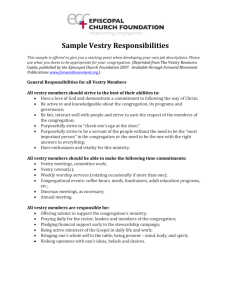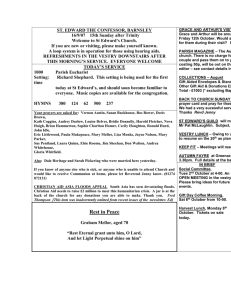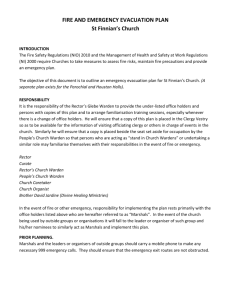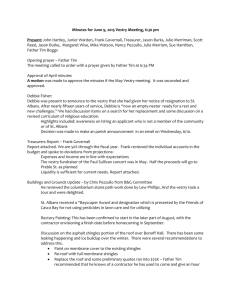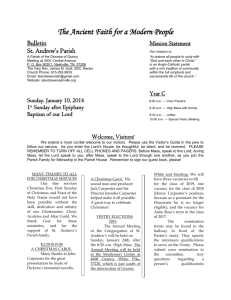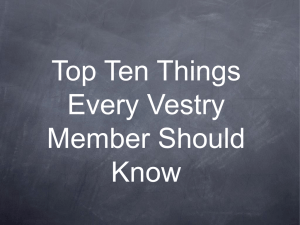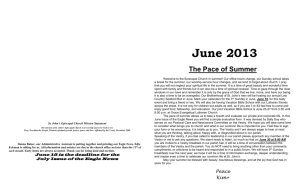Tour of the Vestry Toolbox - Diocese of Central New York
advertisement
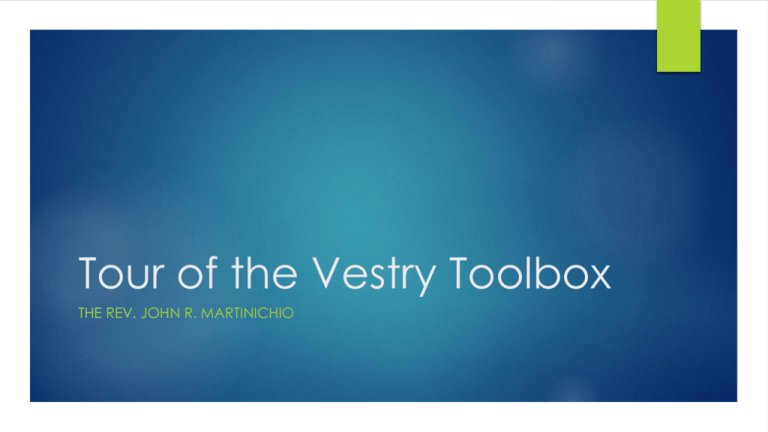
Tour of the Vestry Toolbox THE REV. JOHN R. MARTINICHIO History of the Vestry The term vestry originated in Great Britain and referred to the room next to the nave of the church where the sacred vessels and vestments were kept. Those conducting parish businesses met in this room and came to be known as the vestry. The executive committee of the vestry is made up of the two wardens and the rector. The principle behind this, as well as the whole structure of the Episcopal Church and the Anglican Communion, is one of ordered and diffused authority. Vestry Notebook •St. Paul’s By-Laws •Canons and Constitutions of the Episcopal Church •Canons and Constitutions of the Diocese of Central New York •New York State Religious Corporation Laws • Of Business Methods In Church Affairs •Bernice Gould Memorial Fund and Letter of Agreement with the Goul •Bernice Gould Memorial Fund Application •Bernice Gould Scholarship By-Laws •St. Paul’s Policy Manual •Manual of Church Business Affairs Confidentiality Statement Confidential information about constituents (donors and non-donors) in oral form or electronic, magnetic, or print media is protected so that the relationship of trust between the constituent and St. Paul’s Church is upheld. I. Responsibility •Each authorized user of church data will be responsible and held accountable for its appropriate use. •Use of data for any non-church purpose, such as commercial or political applications, is strictly prohibited. •The Rector will be responsible for informing staff, Vestry members and others about the confidentiality statement. The Rector will also maintain files of signed statements of understanding. II. Circulation manner and medium •Constituent information is the property of St. Paul’s Church and will not be given to persons other than those who are involved with the cultivation or solicitation effort or those who need that information in the performance of their duties for St. Paul’s Church. •Constituent information for St. Paul’s Church will not be shared with another institution. •Documents containing constituent information shall be clearly marked "confidential." •Vendors, consultants, and other external entities shall understand and agree to comply with St. Paul’s Church’s confidentiality policies before gaining access to data. •Donors will have forthright and prompt access to their own donor file upon request, and may view their own records, but may not access the records of other individuals. I, ______________________, understand and agree to implement the above policies and practices when dealing with constituent records, documents and information. Conflict of Interest Policy 1. Purpose: St. Paul’s Episcopal Church, including its Rector, Wardens, Vestry members and employees, have a clear obligation and commitment to conduct all affairs of the church in accordance with the highest standards of integrity and ethics and in compliance with applicable federal and state laws and with the standards set forth below related to conflict of interest and commitment to the best interests of the church. All members of St. Paul’s Church must avoid conflicts of interest or any appearance of conflicts between their own personal interest and the interests of the church. All members are obligated to avoid any situation in which as actual or potential conflict of interest could arise. Any situation or activity involving potential conflict of interest must be disclosed in advance in accordance with the policy and procedures set forth below. This policy if intended to supplement but not replace any applicable state and federal laws governing conflict of interest applicable to our church. Remaining Sections 3. Duty to Disclose: 4. Due Diligence Procedures: 5. Policy Violations: 6. Documentation: 7. Compensation Matters: 8. Annual Statements: 9. Periodic Reviews: 10. Use of Outside Experts: Definitions For purposes of this policy, the following definitions apply: 1.Interested person. Any Rector, Warden, Vestry Members and employee or member of a committee with governing board delegated powers who has a direct or indirect financial interest, as defined below, is an interested person. 2.Financial interest. A person has a financial interest if the person has, directly or indirectly, through business, investment or family: *An ownership or investment interest in any entity with which St. Paul’s Church has a transaction or arrangement. *A compensation arrangement with St. Paul’s Church or with any entity or individual with which the church has a transaction or arrangement. *A potential ownership or investment interest in, or compensation arrangement with, any entity or individual with which the church is negotiating a transaction or arrangement. The term compensation includes direct and indirect remuneration as well as gifts or favors that are not insubstantial. A financial interest is not necessarily a conflict of interest (see section 4). Parish Secretary, Paid Staff Christian education Sunday School-Teachers First Communion Class Confirmation Class Adult Education Welcoming Ministry Visitor Packets/Contacts Inquirer’s Class Vestry Fellowship Finance Committee Budget/Audit/Counters Investments, Memorials, Treas. OFFICE OF THE RECTOR Youth Youth Group, Gould Scholarship Comm.Rector, Youth Service, Fund-Raisers, Youth Events Rector, Wardens (2) Vestry The Rev. John R. Martinichio Bruce Dailey/J. Westermann Eunice Barton Dolly Chergosky Karen Cahill Mary Gilfoyle Lynne Jones Jennifer Kakusian Lynda Helmer Bob Pettit Beth Vandervort J. Westermann, Treasurer Linda Littel Clerk Facilities Committee Maintenance of Building, Quotes, Major Improvements, Grounds, Snow Removal. Parish Community Historian, All Parish Meals, WOC, Parish Receptions, Easter Breakfasts, Executive Committee Stewardship Every Member Canvass Capital Campaign, Pledging Worship Comm. – Rector Acolytes-Carl Dollmetsch Ushers 8-Chip Kinne Ushers 10-Ken Kidder Lectors-Sue Jones Altar Guild-Mitzi Manning Music-Paula Giroux Prayer Chain-Barb Dailey Eucharistic Minister’s Pastoral Care Homebound/Nursing Home Acute Care/Hospitals, Prayer Chain, Eucharistic Minister’s, Drive people to church, Flower Delivery Parish Nurse Outreach Ice Cream Social-Eunice, Rummage Sale-WOC, CHOWCHOW Garden CHAP Harvest Dinner Spiritual Development-Rector Bible Study Forum Communications Publicity, Epistle, Bulletin, Web Site Submissions, Advertising for Events Vestry Responsibilities? •Set and Monitor Parish Focus, Raise Resources, Be the Chief Stewards of the property of the parish •Oversee Existing Committees-check with committee chairs monthly •Act as the Vestry Liaison for Committee Chairs-report any news-regularly attend Vestry meetings •Help Find Leaders and Organize Events if needed (Responsible for Open House) •Arrange for Any Committee to Report to the Vestry-help put on agenda •Aid Committee Chairs with Budget and Budget Needs Episcopal Church http://www.episcopalchurch.org/ Episcopal Church Foundation 815 Second Avenue New York, New York 10017 ecf@episcoplafoundation.org 800-697-2858 212-697-2858 Vestry Papers http://www.ecfvp.org/vestrypapers/ Facebook Twitter Vestry Handbook The Vestry Resource Guide Serving on a vestry is an adventure in faith. And The Vestry Resource Guide is the ultimate companion to help each and every vestry member embark on that adventure. Whether you’re a first time vestry member or a seasoned veteran, The Vestry Resource Guide provides information and handy, how-to advice on your responsibilities. Topics covered include: the ministry of the vestry, leading a community of faith, origins of conflict, stewardship, and navigating transitions in clergy leadership. In addition to loads of practical information, you’ll also find helpful biblically based personal and vestry reflection questions. The Vestry Resource Guide is distributed by Forward Movement and can be ordered calling 800-543-1813. The cost is $12.00 per copy/$10.00 per copy for order of 10 books or more. No vestry should be without this easy to use book. Alban Institute https://alban.org/ Provides education sources, books, publications and consulting services for clergy and congregations. Membership required for weekly e-mail and discount on books. Church Next https://www.churchnext.tv https://churchnextblog.wordpress.com/ Job Description Clerk of the Vestry Selected By Rector/Wardens and approved by the Vestry Term One Year, Renewable Duties 1. Keep official Minutes of all Vestry Meetings and Annual Meetings 2. Call Special Vestry Meetings at the Request of the Rector or 2/3 of the total vestry and wardens. 3. Conduct correspondence on behalf of the Vestry. 4. Serve as custodian for the official seal. 5. Attend all Vestry meetings as a non-voting member. 6. File the minutes of every meeting with the Parish Office by the second Thursday following each meeting. 7. Record meeting attendance in the minutes. 8. Handle official correspondence, such as certificates of election for representatives to the diocesan convention. 9. Other duties as assigned by the Rector or Vestry Elevator Pitch From Wikipedia, the free encyclopedia An elevator pitch, elevator speech, or elevator statement is a short summary used to quickly and simply define a profession, product, service, organization, or event and its value proposition. The name "elevator pitch" reflects the idea that it should be possible to deliver the summary in the time span of an elevator ride, or approximately thirty seconds to two minutes and is widely credited to Ilene Rosenzweig and Michael Caruso (while he was Editor for Vanity Fair) for its origin.[2][3] The term itself comes from a scenario of an accidental meeting with someone important in the elevator. If the conversation inside the elevator in those few seconds is interesting and value adding, the conversation will continue after the elevator ride or end in exchange of business cards or a scheduled meeting.[4] A variety of people, including project managers, salespeople, evangelists, and Policy makers, commonly rehearse and use elevator pitches to get their points across quickly Another Definition by Duke University An elevator pitch or 1-minute commercial is a short introduction of your career skills, experience and interests. It's designed to help you briefly communicate your personal brand any time you meet a potential employer, client or contact. The term "elevator pitch" reflects the idea that it should be possible to deliver your personal selfmarketing summary in the time span of an elevator ride, or approximately 30 seconds to two minutes. The term itself comes from a scenario of an accidental meeting with someone important in the elevator. If the conversation inside the elevator in those few seconds is interesting and value adding, the conversation will continue after the elevator ride, or end in exchange of business cards or a scheduled meeting. When you only have a few minutes of someone's time, having a well-prepared, elevator pitch can make those few minutes count. A successful pitch is where the other person relaxes and says, "Interesting. Tell me more." The Elevator Pitch Presenting your research in conversation by Matthew Capdevielle, PhD, University Writing Center Ralf Bendlin, Electrical Engineering Gretchen Busl, Literature Definition • a concise statement of your research interests and experience to be shared informally and orally in various professional contexts. • a brief encounter with a scholar in your field at a conference • introductions around a table at the beginning of meeting • introduction to a guest speaker in the hallway right before his/her talk • conversation at a reception for a speaker • an actual elevator ride with a search committee member The Goal • to create a memorable and positive impression • to open the door to further conversation Question to include: • What is the topic of your research? • What is the problem, issue, or question that you are asking and addressing in your research? • Why is that problem interesting and important? (i.e. So what?) • How does your work connect with a broader disciplinary conversation about this topic/problem in your field, and what does it add to that conversation? Crafting Language • key nouns • offer topical touchstones that are accessible to wide range of educated people • avoid jargon if possible or deliver specialized terms using appositives • action verbs • express relationships among these key nouns using action verbs • describe the movement of your work and the activity or action of your involvement Delivery • Eye contact--read your listener • Enthusiasm • Practice, practice, practice! Cocktail Party Pitch Contexts • telling friends or family what you do • discussing your work at poster sessions with possible collaborators, peers, etc. • cocktail parties, receptions, lunch meetings, campus visit engagements • Features • Conversational, more of an exchange, an actual dialogue • Listen very carefully, and respond! • Seek connections between your research interests and your interlocutor’s interests • Ask questions CREATING YOUR ELEVATOR PITCH Keep your commercial simple and brief, and always include who you are, what you want to do and why it matters (or what the employer/client will get out of it). Use a story or example to demonstrate your best qualities. Use strong, action-packed words and speak in a confident, personable tone. Be relevant. List the accomplishments (paid, unpaid, work, education or life experiences) that are relevant and compelling to your audience. If job searching, be clear about the job title, function and industry you are interested in. Practice your commercial, but don't memorize; you want to sound natural! Make a connection between yourself and your new acquaintance. End with a question to draw the contact into the conversation. Where to use your elevator pitch in an interview, in response to, "Tell me about yourself." in a follow-up phone call or email, to summarize your qualifications and interest while networking, to help you make a clear, positive first impression at a career fair, to introduce yourself quickly to employers Consent Agenda At every board meeting, at least a few items come to the agenda that do not need any discussion or debate either because they are routine procedures or are already unanimous consent. A consent agenda (Roberts Rules of Order calls it a consent calendar) allows the board to approve all these items together without discussion or individual motions. Depending upon the organization, this can free up anywhere from a few minutes to a half hour for more substantial discussion.. What belongs on a consent agenda Typical consent agenda items are routine, procedural decisions, and decisions that are likely to be noncontroversial. Examples include: Approval of the minutes; Final approval of proposals or reports that the board has been dealing with for some time and all members are familiar with the implications; Routine matters such as appointments to committees; Staff appointments requiring board confirmation; Reports provided for information only; Correspondence requiring no action. Only works if: A consent agenda can only work if the reports and other matters for the meeting agenda are known in advance and distributed with agenda package in sufficient time to be read by all members prior to the meeting. A typical procedure is as follows: and 1. When preparing the meeting agenda, the president or chairperson determines whether an item belongs on the consent agenda. 2. The president prepares a numbered list of the consent items as part of, or as an attachment to the meeting agenda. 3. The list and supporting documents are included in the board’s agenda package in sufficient time to be read by all members prior to the meeting. 4. At the beginning of the meeting, the chair asks members what items they wish to be removed from the consent agenda and discussed individually. Finally 5. If any member requests that an item be removed from the consent agenda, it must be removed. Members may request that an item be removed for any reason. They may wish, for example, to discuss the item, to query the item, or to register a vote against the item. 6. Once it has been removed, the chair can decide whether to take up the matter immediately or place it on the regular meeting agenda. 7. When there are no more items to be removed, the chair or secretary reads out the numbers of the remaining consent items. Then the chair states: “If there is no objection, these items will be adopted.” After pausing for any objections, the chair states “As there are no objections, these items are adopted.” It is not necessary to ask for a show of hands. 8. When preparing the minutes, the Secretary includes the full text of the resolutions, reports or recommendations that were adopted as part of the consent agenda. Start using it In order to start using a consent agenda, the board should first adopt a rule of order allowing for the consent agenda process. A sample rule is: “A consent agenda may be presented by the president at the beginning of a meeting. Items may be removed from the consent agenda on the request of any one member. Items not removed may be adopted by general consent without debate. Removed items may be taken up either immediately after the consent agenda or placed later on the agenda at the discretion of the assembly. It is important to make sure that all directors know what items belong on the agenda and how to move items to and from the consent agenda. For this reason, instruction on using the consent agenda should be part of the board orientation program. Pray At the beginning At the conclusion (Compline) At point during the meeting before votes especially when discussion as been long or the decision is a BIG one. Tips Prepare for the meeting. Read the material Structure vestry each member is responsible for a parish committee, loosely divided in reach/outreach or ministry/administration. Some more tips put the biggest conversation topic first, reports and financial reports at the end submit written reports beforehand Distribute material way before the meeting. Length-short No More Parking Lot Meetings Do this instead! First, recognize that as leaders in Christian community, we are called to teach and model a higher standard of communication. Call out unhealthy behaviors when you see it or experience it as a leader in a congregation, taking the time to do so in a caring way. Establish a culture of listening and caring through the use of covenants, norms, clear ministry descriptions, and holding people accountable. Take the time to learn together how to be a faithful leader, which might include Bible study, prayer, and sharing appreciations and regrets. Evaluate your congregation’s health using 12 marks of healthy church behavior and its related assessment tools. Recognize and empower healthy spiritual leaders by placing them in positions of authority and influence. Practice patience and persistence, allowing time for new behaviors to become the norm. Questions, Comments, Suggestions ? Thank you!
